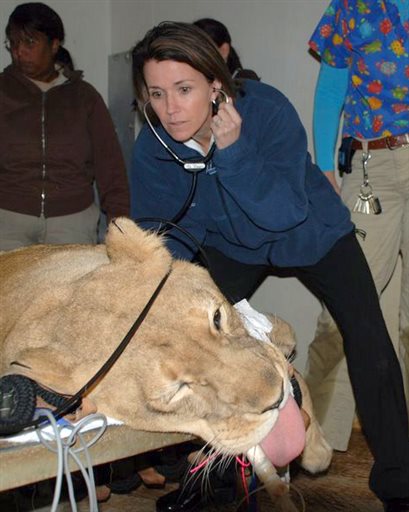
By VERENA DOBNIK
In this 2008 photo provided by Barbara Natterson-Horowitz, M.D., Dr. Natterson-Horowitz listens to the heart of a female lion at the Los Angeles Zoo and Botanical Garden after a successful cardiac procedure that she completed along-side veterinarians. On Saturday, Nov. 2, 2013, physicians and veterinarians are teaming up to explore the questions related to fighting diseases affecting both animals and people in the “Zoobiquity” conference. The event takes its name from a best-selling book on the subject by Natterson-Horowitz. (AP Photo/Barbara Natterson-Horowitz, M.D.)
Barbara Natterson-Horowitz
In this undated photo provided by Barbara Natterson-Horowitz, M.D., Dr. Natterson-Horowitz inserts a probe into the esophagus of a western lowland gorilla to perform a diagnostic test on its heart as part of preventive cardiac care for the animal, at the Los Angeles Zoo and Botanical Gardens. Dr. Natterson-Horowitz will be among the doctors attending the “Zoobiquity” conference in New York on Saturday, Nov. 2, 2013. The event takes its name from her best-selling book on the health connection between humans and animals. (AP Photo/Barbara Natterson-Horowitz, M.D.)
Barbara Natterson-Horowitz
In this undated photo provided by Barbara Natterson-Horowitz, M.D., Dr. Natterson-Horowitz watches the monitor as she performs an echocardiogram on the heart of a western lowland gorilla after inserting the probe down the animals esophagus, at the Los Angeles Zoo and Botanical Gardens. Dr. Natterson-Horowitz will be among the medical professionals who treat both animals and humans that will attend the “Zoobiquity” conference in New York on Saturday, Nov. 2, 2013. The event takes its name from her best-selling book on the health connection between humans and animals. (AP Photo/Barbara Natterson-Horowitz, M.D.)
Prev
1 of 3
Next
NEW YORK (AP) — What do Siberian tigers and post-menopausal women have in common?
That is among the questions related to fighting diseases affecting both animals and people that physicians and veterinarians are teaming up to explore at a conference in New York on Saturday.
A global authority on breast cancer, Memorial Sloan-Kettering Cancer Center’s Dr. Larry Norton, will present information on causes and treatments for the disease prevalent in older women and among Siberian tigers and other large jungle cats.
Scientists also will discuss a male gorilla with a seizure disorder, tumors in domestic ferrets and a California sea lion with an eating disorder.
The Zoobiquity conference takes its name from a best-selling book by Dr. Barbara Natterson-Horowitz, a cardiologist at the UCLA Medical Center who says that about 60 percent of diseases found in humans also hit most animal species.
Scientists from medical hubs including the David Geffen School of Medicine at UCLA, the National Institutes of Health and The Wildlife Conservation Society at the Bronx Zoo will compare animal and human cases.
“I believe I’ll learn something from human-line physicians Saturday that could be immediately applied on Sunday to my animal patients, and perhaps they’ll learn things from me for their human patients,” said Dr. Richard Goldstein, chief medical officer at New York’s Animal Medical Center.
Another shared illness being examined is malaria, in penguins and people, and how it spreads through populations of birds in the wilderness.
Goldstein pointed out that veterinarians are able to study innovative treatments on animals before such trials can be conducted on humans. Some of those treatments are now being used on humans, including a melanoma cancer vaccine developed for dogs at Animal Medical Center that led to ongoing studies in patients at Sloan Kettering.
“Animals are models for human diseases and because their life spans are shorter, the progression of a disease is more obvious,” Goldstein said.
Especially useful to human medicine is how veterinarians approach behavioral and psychological problems, since their patients don’t talk, just as humans with dementia or Alzheimer’s may not be able to communicate.
“Vets are treating animals with anxiety or obsessive compulsive disorders, eating disorders, addictions — like wallabies in Tasmania eating poppies,” Natterson-Horowitz said. “They look at environmental and genetic factors, and stress, and that informs the human cases.”
Natterson-Horowitz started the animal-human medical dialogue about a decade ago when the Los Angeles Zoo asked the UCLA professor to help them tackle heart conditions in some great apes.
“I was a typical cardiologist, dealing with heart attacks, atrial fibrillation and high cholesterol,” she said. “That opened my eyes to the concept of one health: All doctors can be thought of as veterinarians since all patients are animals.”



